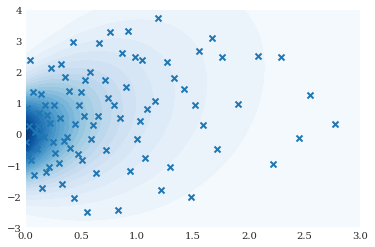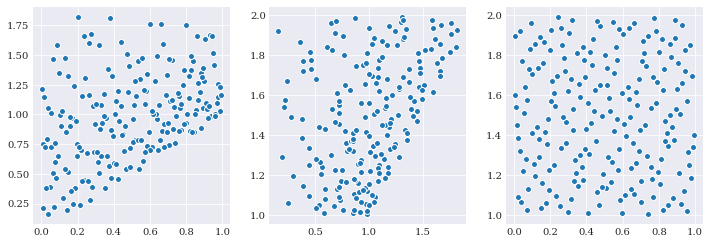Dependent random variable¶
Some times simple stochastically independent random variables are not enough, and one have to use variables with stochastic dependencies. In chaospy such variables can be created through parameter declarations.
To demonstrate, let us start through example: a Gaussian distribution that depend on a gamma distribution through its mu and sigma parameter:
[1]:
import chaospy
dist1 = chaospy.Gamma(1)
dist2 = chaospy.Normal(mu=dist1, sigma=dist1+1)
joint = chaospy.J(dist1, dist2)
joint
[1]:
J(Gamma(1), Normal(mu=Gamma(1), sigma=Add(Gamma(1), 1)))
The resulting distribution can be used as any other distribution in chaospy. For example, here is the contour plot of the probability density function together with (quasi-)random samples:
[2]:
import numpy
from matplotlib import pyplot
grid = numpy.mgrid[0:3:100j, -3:4:100j]
pyplot.contourf(grid[0], grid[1], joint.pdf(grid), 30)
pyplot.scatter(*joint.sample(100, rule="halton"), marker="x")
pyplot.axis([0, 3, -3, 4])
[2]:
(0.0, 3.0, -3.0, 4.0)

In chaospy dependencies are handled by assuming all distributions have a known chain rule decomposition:
As long as this decomposition is possible, chaospy will figure out how to assemble the joint density function, and random sampling. For examples, is the following allowed:
[3]:
dist_lo = chaospy.Uniform(0, 1)
dist_up = chaospy.Uniform(1, 2)
dist_mid = chaospy.Uniform(dist_lo, dist_up)
joint_ordered = chaospy.J(dist_lo, dist_mid, dist_up)
joint_ordered.sample(5, rule="halton").round(5)
[3]:
array([[0.375 , 0.875 , 0.0625 , 0.5625 , 0.3125 ],
[0.56722, 1.18889, 1.46472, 0.60981, 0.59676],
[1.24 , 1.44 , 1.64 , 1.84 , 1.08 ]])
or visually:
[4]:
samples = joint_ordered.sample(200, rule="halton")
pyplot.rc("figure", figsize=[12, 4])
pyplot.subplot(131)
pyplot.scatter(samples[0], samples[1])
pyplot.subplot(132)
pyplot.scatter(samples[1], samples[2])
pyplot.subplot(133)
pyplot.scatter(samples[0], samples[2])
pyplot.show()

Having random samples and probability density function available, allows for use of generalized polynomial chaos.
Limitations¶
The functionality described above allows for creating the joint probability density function and joint random samples. In practice the latter is possible because chaospy constructs the forward and inverse Rosenblatt transformation. However, it is important to note that dependent random variables likes these can not be used for everything. For example, when creating quadrature nodes and weights, rules not dependent on distributions, like Fejér, works fine:
[5]:
nodes, weights = chaospy.generate_quadrature(2, joint, rule="fejer_2")
nodes.round(4), weights.round(6)
[5]:
(array([[ 4.721 , 4.721 , 4.721 , 16.1185, 16.1185, 16.1185,
27.516 , 27.516 , 27.516 ],
[ 37.7152, 148.6125, 259.5099, 37.7152, 148.6125, 259.5099,
37.7152, 148.6125, 259.5099]]),
array([2.00850e-02, 0.00000e+00, 0.00000e+00, 8.51019e-01, 0.00000e+00,
0.00000e+00, 8.00000e-06, 0.00000e+00, 0.00000e+00]))
However, rules that directly is built on properties taken from the distributions, and in particular, those assuming stochastic independence, can not work. For example optimal Gaussian quadrature:
[6]:
import pytest
with pytest.raises(chaospy.StochasticallyDependentError):
chaospy.generate_quadrature(2, joint, rule="gaussian")
The same limitation also prevents the construction of joint cumulative distribution function.
Illegal distribution¶
Note that the distribution of interest here, joint is the joint distribution including both the Gaussian and the Gamma distribution. The conditional Gaussian distribution dist2 is created and part of this, but on its own can not be used for anything. In fact, trying to use conditional distributions in chaospy will cause an error:
[7]:
with pytest.raises(chaospy.StochasticallyDependentError):
dist2.sample(10)
In other words, though any dependencies can be modeled in chaospy, declaring those distributions might sometimes be challenging. For example, a transformation like:
[8]:
dist1 = chaospy.Uniform(0, 1)
dist2 = chaospy.Normal(0, 1)
joint_illegal = chaospy.J(dist1+dist2, dist1-dist2)
with pytest.raises(chaospy.StochasticallyDependentError):
joint_illegal.sample(10)